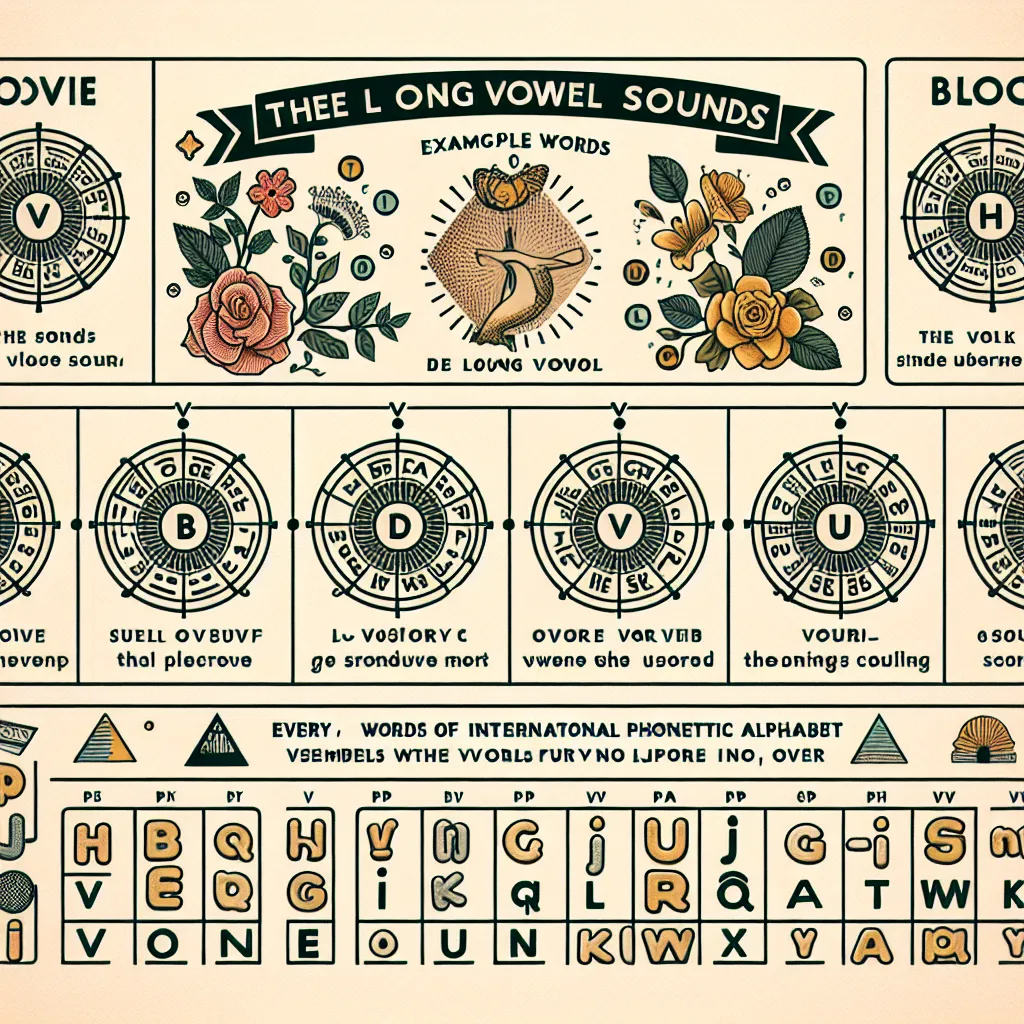Long vowel sounds are an essential part of English pronunciation, and mastering them can significantly improve your spoken English. In this comprehensive guide, we’ll explore How To Pronounce English Words With Long Vowels, providing you with valuable tips and techniques to enhance your pronunciation skills.
Understanding Long Vowels in English
Long vowels are vowel sounds that are pronounced as their letter name. In English, there are five long vowel sounds: A, E, I, O, and U. These sounds are crucial for correct pronunciation and can change the meaning of words when mispronounced.
 English Long Vowel Chart
English Long Vowel Chart
The Five Long Vowel Sounds
- Long A (/eɪ/): as in “cake” or “rain”
- Long E (/iː/): as in “bee” or “scene”
- Long I (/aɪ/): as in “kite” or “fly”
- Long O (/oʊ/): as in “go” or “snow”
- Long U (/juː/ or /uː/): as in “cute” or “blue”
Techniques for Pronouncing Long Vowels
1. Listen and Repeat
One of the most effective ways to improve your pronunciation of long vowels is through listening and repetition. Use resources like pronunciation guides, audio dictionaries, or native speaker recordings to hear the correct pronunciation.
- Listen carefully to the sound.
- Repeat the sound slowly, focusing on the shape of your mouth and the position of your tongue.
- Practice regularly, gradually increasing your speed.
2. Use Phonetic Transcriptions
Phonetic transcriptions can be incredibly helpful in understanding how to pronounce long vowels correctly. The International Phonetic Alphabet (IPA) provides a standardized way to represent sounds.
For example:
- Long A: /eɪ/ as in “make” /meɪk/
- Long E: /iː/ as in “see” /siː/
Familiarize yourself with these symbols and practice pronouncing words using their phonetic transcriptions.
3. Mirror Practice
Using a mirror while practicing can help you visualize the correct mouth and lip positions for long vowel sounds.
- Stand in front of a mirror.
- Pronounce the long vowel sound slowly.
- Observe your mouth shape and lip position.
- Adjust as necessary to match the correct pronunciation.
Common Mistakes and How to Avoid Them
When learning to pronounce English words with long vowels, learners often encounter some common pitfalls. Here are a few to watch out for:
-
Confusing long and short vowel sounds:
- Incorrect: Pronouncing “beat” as “bit”
- Correct: /biːt/ not /bɪt/
-
Mispronouncing diphthongs:
- Incorrect: Pronouncing “made” as “med”
- Correct: /meɪd/ not /med/
-
Overemphasizing the length of long vowels:
- Incorrect: Stretching “sheep” to sound like “sheeeeep”
- Correct: Maintain a natural length without exaggeration
To avoid these mistakes, focus on listening to native speakers and practicing regularly. Pay attention to the subtle differences between long and short vowel sounds.
Practical Exercises for Long Vowel Practice
-
Minimal Pair Drills:
Practice with word pairs that differ only in their vowel sound:- beat (long E) vs. bit (short I)
- cake (long A) vs. keck (short E)
- kite (long I) vs. kit (short I)
-
Tongue Twisters:
Use tongue twisters to practice long vowel sounds in context:- “The chief’s brief speech made Eve grieve.”
- “The blue moon grew too soon.”
-
Reading Aloud:
Choose texts with many long vowel words and practice reading them aloud. Focus on maintaining correct pronunciation throughout.
 Long Vowel Practice Exercise
Long Vowel Practice Exercise
The Phonemic Chart and Commonly Mispronounced Words
Understanding the phonemic chart can greatly aid in mastering long vowel pronunciation. Here’s a simplified version focusing on long vowels:
- /eɪ/ – Long A
- /iː/ – Long E
- /aɪ/ – Long I
- /oʊ/ – Long O
- /juː/ or /uː/ – Long U
Here are 10 commonly mispronounced words containing long vowels:
- “Great” (/greɪt/) – often mispronounced as /griːt/
- “Receive” (/rɪˈsiːv/) – often mispronounced as /rɪˈsaɪv/
- “Height” (/haɪt/) – often mispronounced as /heɪt/
- “Bow” (as in bow and arrow) (/boʊ/) – often confused with “bow” (/baʊ/) meaning to bend
- “Beautiful” (/ˈbjuːtɪfəl/) – often mispronounced as /ˈbjuːtɪfʊl/
- “Gauge” (/geɪdʒ/) – often mispronounced as /gɔːdʒ/
- “Tomb” (/tuːm/) – often mispronounced as /tɒm/
- “Suite” (/swiːt/) – often mispronounced as /sjuːt/
- “Aisle” (/aɪl/) – often mispronounced as /eɪsəl/
- “Colonel” (/ˈkɜːrnəl/) – often mispronounced as /kəˈləʊnəl/
To correct these mispronunciations, focus on the long vowel sounds and practice them in isolation before incorporating them into the full word.
Conclusion
Mastering the pronunciation of English words with long vowels is a crucial step in improving your overall English speaking skills. By understanding the five long vowel sounds, practicing regularly with the techniques provided, and being aware of common mistakes, you can significantly enhance your pronunciation.
Remember, consistent practice and exposure to native English speakers are key to improving your pronunciation. Don’t be afraid to make mistakes – they’re a natural part of the learning process. Keep practicing, and you’ll soon notice a significant improvement in your ability to pronounce English words with long vowels correctly.
For more tips on improving your English pronunciation, check out our guide on pronunciation tips for non-native speakers of English. You might also find our article on how to improve pronunciation using guided practice helpful in your journey to mastering English pronunciation.




